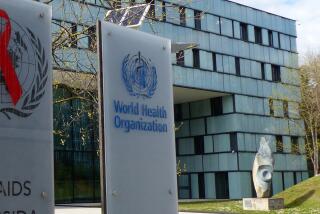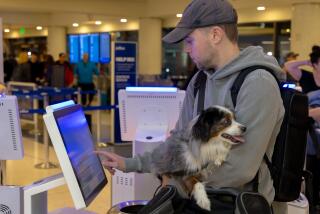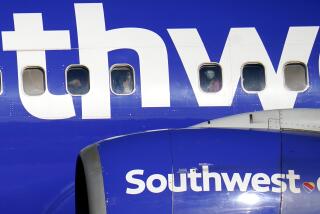To avoid germs on an airplane, consider booking a window seat

- Share via
If you’re the type of traveler who worries about catching the flu or another dreaded disease from a fellow airline passenger, a new study should put your mind at ease.
If a plane takes off with one infected flier, it is likely to land on the other side of the country with only 1.7 infected fliers, researchers found.
What you really need to watch out for is a flight attendant with a cough or runny nose. A single one of them can infect 4.6 passengers during a transcontinental flight.
A group that dubbed itself the FlyHealthy Research Team came to these conclusions after flying back and forth from Atlanta to the West Coast on 10 flights and paying extremely close attention to the movements in the economy-class portion of the cabin.
Ten researchers boarded each flight and spaced themselves in pairs five to seven rows apart, sitting in seats on opposite sides of the aisle. From these prime vantage points, they took copious notes on who went where. Then they recorded each step in an iPad app.
Over the course of the 10 flights — which lasted between 3 hours and 31 minutes and 5 hours and 13 minutes — several patterns emerged:
• Passengers seated along the aisle were much more likely to move about the cabin than passengers seated next to a window. Overall, 57% of those in window seats stayed put for their entire flight, compared with 48% of those in middle seats and 20% of those in aisle seats.
• There were two main reasons for people to get up during the flight — to go to the lavatory or to access the overhead bin.
• Among all 1,296 passengers on all 10 flights, 84% had “close contact” with another passenger seated more than 1 meter away. The typical number of such contacts was 44, and they tended to last for 24 seconds. For most travelers, these encounters added up to between 18 and 98 minutes, with a median time of 47 minutes.
• Crew members typically spent 67 minutes — about one-third of their flight time — “in contact with passengers,” the researchers wrote. However, their total amount of contact with passengers added up to 1,149 “person-minutes” on a typical flight, compared with only 206 minutes of contact with fellow crew members.
The researchers used all this data to simulate what would happen if a passenger in seat 14C (an aisle seat) were sick. To be conservative, they used an transmission rate that was four times higher than a real-life example from 1977, when 54 passengers and crew were forced to sit on the tarmac for 4.5 hours and 38 of them became sick with an influenza-like illness as a result.
Even under these circumstances, the odds that a single passenger would start an outbreak were extremely low.
For the 11 closest passengers — those seated in rows 13, 14 or 15, in seats A through D — the odds of being infected were “high,” the researchers wrote. But for everyone else on the plane, the odds of being sickened by the person seated in 14C were less than 0.03.
For the plane as whole, the simulations showed that on average, only 0.7 additional passengers would become sick over the course of the cross-country flight.
The researchers repeated their work with simulations that placed sick passengers in other seats. In the worst-case scenario, only two people became infected as a result of their in-flight exposure to another passenger.
A sick flight attendant was another story, however.
Since these crew members move all around the cabin and get close to so many passengers, they have much more opportunity to spread disease-causing germs. The researchers calculated that one sick crew member would infect 4.6 passengers, on average, even though these simulations used a lower transmission rate.
“A crew member is not likely to come to work while being extremely sick,” the researchers explained. “If she or he came to work, she or he would be more likely to take medication to reduce or eliminate coughing.”
That may seem like wishful thinking, but tests of airplane germiness revealed the cabins were so clean that they were unlikely to have been serviced by sick workers.
Over the 10 flights, the researchers took 229 samples of cabin air and swabs of surfaces like tray tables, seat belt buckles and lavatory door handles. None of those samples contained genetic evidence for any of 18 common respiratory viruses — a striking finding considering that eight of the flights occurred during flu season.
The researchers cautioned that their results could only be applied only to transcontinental flights on planes with a single aisle and three seats on either side. (All of the planes in this study were Boeing 757s or 737s.)
Passengers would likely behave differently on shorter-hop flights or on longer-haul flights from one continent to another. That would affect the disease transmission dynamics in the cabin, as would other cabin configurations with more aisles (and thus fewer seats that are far from an aisle).
The FlyHealthy team also noted that their simulations included only transmission by droplet — cases of germs spreading via cough or sneeze, for instance. They did not try to model the transmission of “virus-laden particles,” which can travel further and linger longer.
Even the most powerful supercomputers have trouble performing the calculations necessary to take these into account, they explained.
Their study was published Monday in the Proceedings of the National Academy of Sciences.
The work was funded in part by Boeing, and one of the researchers was a Boeing employee. Most of the more than two dozen members of the FlyHealthy Research Group were based in Atlanta at Emory University or Georgia Tech.
Follow me on Twitter @LATkarenkaplan and “like” Los Angeles Times Science & Health on Facebook.
MORE IN SCIENCE
The National Academies take a hard look at the safety and quality of abortion care in the U.S.
Henry Waxman explains why it took the FDA so long to regulate the nicotine in cigarettes
Erasing Stephen Hawking’s disability erases an important part of who he was
UPDATES:
March 21, 1:17 p.m.: This article has been updated with details about the research team and the funding source.
This article was originally published on March 19 at 6:15 p.m.







